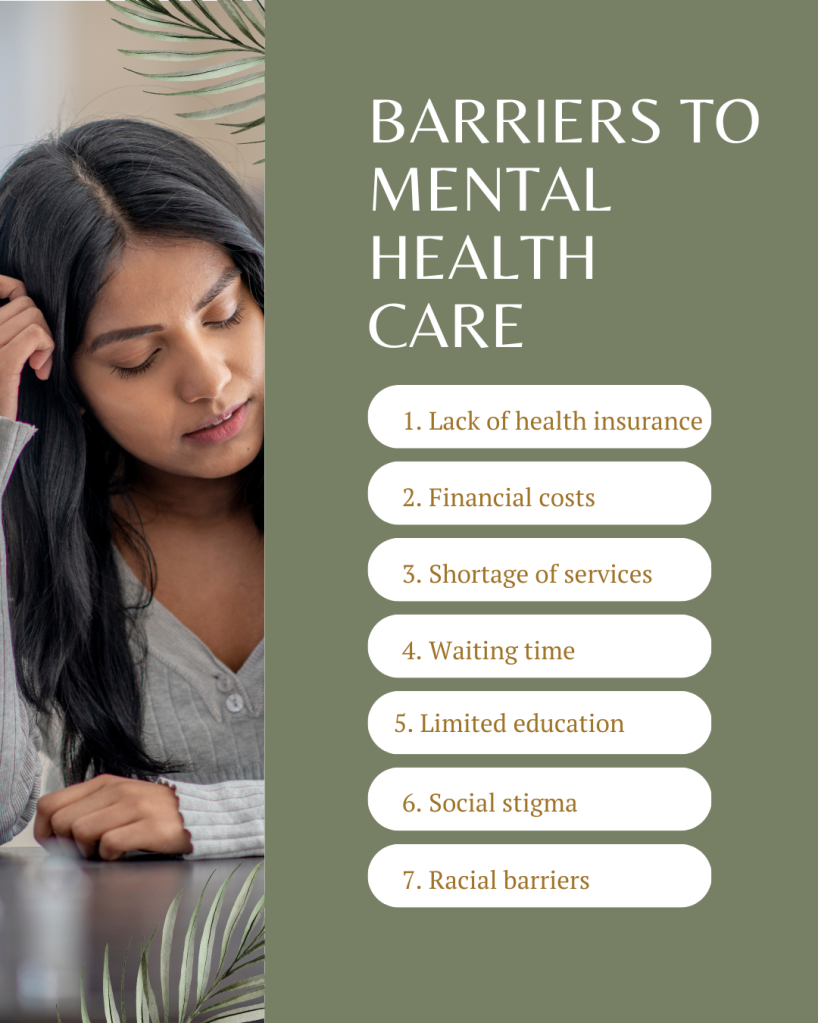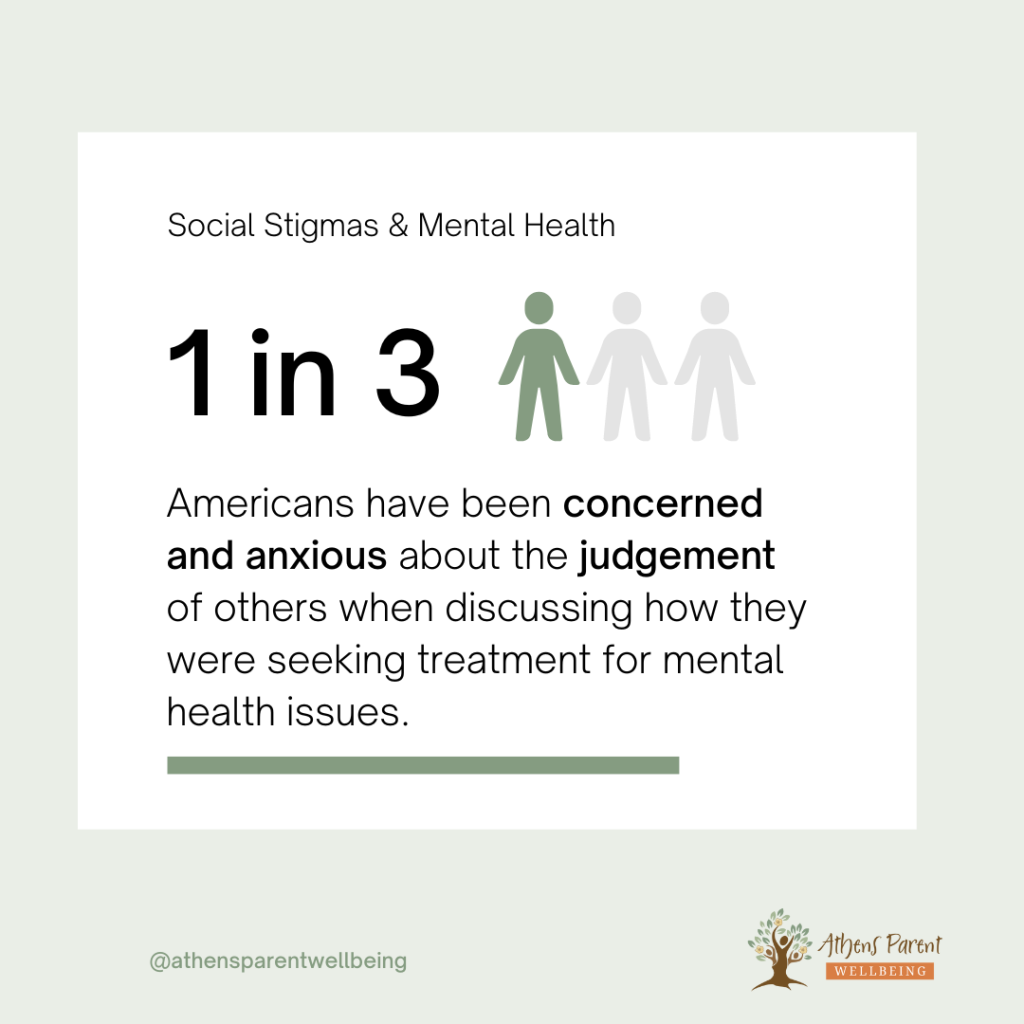Mental health problems are experienced by individuals across the whole nation. In fact, 1 in 5 Americans have experienced a mental health issue at some point, and 1 in 20 Americans are currently living with a serious mental illness. Mental illnesses can range from schizophrenia to bipolar disorder or to major depression. Despite the prevalence of mental health disorders in the United States, more than half of Americans with a mental illness do not receive the treatment and care they need to manage their symptoms (5 Barriers to Mental Health Treatment and Access to Care, 2022). Struggling with a mental disorder on your own is extremely challenging, so it is important to consider the barriers to receiving to treatment and ways that these obstacles can be overcome.
The Main Barriers to Treatment

There is a large chasm between those who need mental health treatment and them actually receiving treatment. The current treatment gap in North America is 65.7% (Mongelli et al., 2020).
Individuals who do not receive mental health treatment or do not receive adequate treatment may be facing a wide array of barriers prohibiting them from adequate care. The most common barriers these individuals may face include:
- Lack of health insurance
- Financial costs of treatment
- Shortage of mental health care professionals and services
- Waiting time for services
- Limited mental health education or awareness
- Social stigma of mental health problems and treatments
- Racial barriers to mental health care
Lack of Health Insurance
Currently, there are many individuals in the United States who lack the ability to pay for health insurance. 28 million Americans are without health insurance. Not having access to health insurance can greatly diminish one’s ability to pay for mental health care (Mongelli et al., 2020).
Financial Costs of Treatment
Even individuals who have health insurance may face problems trying to pay for their mental health treatments. For instance, the cost of therapy can be considerably expensive even with health insurance plans that cover mental health care. The cost of a one hour therapy session is typically ranges from $100 to $200. An individual who spends $100 on weekly therapy sessions could end up paying 4,800 for a whole year of therapy (5 Barriers to Mental Health Treatment and Access to Care, 2022).
1 in 4 Americans “reported having to choose between getting mental health treatment and paying for daily necessities.”
(Study Reveals Lack of Access as Root Cause for Mental Health Crisis in America, n.d.)
Shortage of Mental Health Care Professionals and Services
The combination of a high demand for mental health services and the low number of professionals can be a huge barrier in limiting access to mental health services (5 Barriers to Mental Health Treatment and Access to Care, 2022). In fact, 163 million Americans reside in areas that the federal government has defined as being Mental Health Professional Shortage Areas (Shortage Areas, 2023).

The demand for mental health services is very high, with 56% of Americans looking for treatment for them or a loved one. Despite such a high demand for services, a recent study shows that many Americans don’t believe there is hope for accessing these services. The results of this study found that 74% of Americans do not think these services are accessible for everyone, and another 47% consider the options for these services to be limited (Study Reveals Lack of Access as Root Cause for Mental Health Crisis in America, n.d.).
While some areas of the United States have adequate numbers of mental health professionals, certain geographical areas have little to none providers. One public health research study found “substantial variation” for the per capita number of psychiatrists, psychologists, and psychiatric nurse practitioners in the Census geographical areas. This study found that the New England area had the highest per capita number of providers, while the South West Central area had the lowest number. While only 6% of the counties in the New England area lacked providers, 69% of the counties in the South West Central area lacked any providers. Across the whole nation, non-metropolitan areas face significantly lower numbers of mental health providers in comparison to metropolitan areas (Andrilla et al., 2018). For mental health treatments, Texas, Wisconsin and Georgia have been ranked as the lowest states “in terms of lacking adequate number of providers, facilities and funding to support the states’ populations” (Study Reveals Lack of Access as Root Cause for Mental Health Crisis in America, n.d.).

Waiting Time for Services
A recent research study found that access to in-person therapy and psychiatric sessions are a higher priority for Americans facing mental health struggles than obtaining medications for treatment. However, getting access to seeing a provider in person can be extremely difficult to do on a timely basis. It can take long periods of time to receive the services patients desire for mental health sessions, mainly due to the long waiting period for a professional’s availability to open up and also the transportation time it takes to go to their office. In America, ninety-six million people have had to withstand waiting longer than a week for mental health treatments. And nearly half of Americans have reported that they themselves or someone they know has had to commute more than an hour to get treatment for mental health conditions (Study Reveals Lack of Access as Root Cause for Mental Health Crisis in America, n.d.).
Limited Mental Health Education or Awareness
If people do not understand that they are having symptoms of a mental health condition, they are not likely to take steps to be treated. Limited educational background on the signs of mental health problems is a common barrier receiving mental health care. An individual may not have been taught what symptoms are indicative of a certain disorder, and they may also be unaware of how potential treatment options as well (5 Barriers to Mental Health Treatment and Access to Care, 2022).
Social Stigma
Public health research has found that social stigmas of mental health are frequently associated with inhibiting treatment of mental health disorders. A social stigma is when a mental health issue is not supported, valued, or given the grace that it deserves. Believing the social stigmas around mental health conditions and treatment can cause individuals to not want to seek help for their symptoms (5 Barriers to Mental Health Treatment and Access to Care, 2022).
Social stigma about mental health is prevalent in the lives of many individuals. About one-third of Americans have been concerned and anxious about the judgement of others when discussing how they were seeking treatment for mental health issues. And slightly over one-fifth of Americans have lied to get around having to tell others that they were looking into mental health services (Study Reveals Lack of Access as Root Cause for Mental Health Crisis in America, n.d.).

Racial Barriers
The racial and ethnic background of individuals may impact the likelihood of receiving treatment for mental health conditions. A National Health Interview study saw that non-Hispanic white adults (23.0%) were more likely than non-Hispanic black (13.6%) and Hispanic (12.9%) adults to have received any kind of treatment for mental health conditions (Emily P. Terlizzi & Benjamin Zablotsky, 2020). People of color are also more likely to be under the poverty line, making them less likely to have health insurance or afford the treatment they may need (Mongelli et al., 2020).
Here are some facts on why racial or ethnic minorities may face challenging barriers to receiving optimal mental health care -> racial or ethnic minorities are:
- 20%–50% less likely to begin using mental health treatments
- 40%–80% more likely to prematurely end their treatment
- Likely to face misdiagnosis due to unconscious bias and stereotypes
Athens Parent Wellbeing
If you are a parent and seeking mental health care in Athens, GA consider checking out Athens Parent Wellbeing (APW). APW provides therapy, peer support, group support, and doulas to parents who may be experiencing mental health issues. To learn more about their mission, click this link.
Citations
5 Barriers to Mental Health Treatment and Access to Care. (2022, May). https://www.socialsolutions.com/blog/barriers-to-mental-healthcare-access/
Andrilla, C. H. A., Patterson, D. G., Garberson, L. A., Coulthard, C., & Larson, E. H. (2018). Geographic Variation in the Supply of Selected Behavioral Health Providers. American Journal of Preventive Medicine, 54(6), S199–S207. https://doi.org/10.1016/j.amepre.2018.01.004
Emily P. Terlizzi & Benjamin Zablotsky. (2020, September 29). NCHS Data Brief No. 380. https://www.cdc.gov/nchs/products/databriefs/db380.htm
Mongelli, F., Georgakopoulos, P., & Pato, M. T. (2020). Challenges and Opportunities to Meet the Mental Health Needs of Underserved and Disenfranchised Populations in the United States. FOCUS, 18(1), 16–24. https://doi.org/10.1176/appi.focus.20190028
Shortage Areas. (2023, April). Health Resources & Services Administration. https://data.hrsa.gov/topics/health-workforce/shortage-areas
Study Reveals Lack of Access as Root Cause for Mental Health Crisis in America. (n.d.). National Council for Mental Wellbeing. Retrieved April 19, 2023, from https://www.thenationalcouncil.org/news/lack-of-access-root-cause-mental-health-crisis-in-america/

Leave a comment